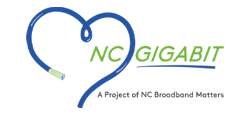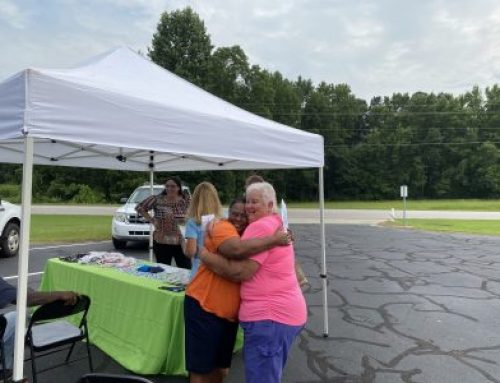By: Fiona Morgan
When Daphne Sykes was 21, an accident nearly severed her spine and left her paralyzed from the neck down. At the time, she was a rising senior at UNC-Charlotte getting ready to start a career. During the medical odyssey that followed, she and her family persevered through rehab and occupational therapy, adjusting their routines and their home. Today, almost four years later, she’s a college graduate working remotely as an accountant from her family’s home in rural Cabarrus County, thanks in no small measure to high-speed internet access.
“She’s been positive throughout this whole situation,” her mother, Lisa Sykes, said. “She’s very energetic. She’s got a dry sense of humor. Her mind is very, very clear. She’s strong in her faith, and very determined.”
The internet is vital to Daphne’s quality of life. It allows her to do everything from operating the lights in her room to communicating with clients. “Broadband really opens up opportunities to her,” Lisa said.
For Daphne, being able to stay in constant communication with her doctor via email is essential. Like many people with spinal cord injuries, Daphne experiences neuropathic pain, often in the form of pins and needles on her feet, as well as muscle spasms. For these and other ongoing health issues, she takes a variety of medications that need frequent adjustment. A mild cold, or even a thunderstorm, can throw her health off balance.
Across North Carolina, people living with complex medical conditions are slowly getting access to telemedicine, the remote diagnosis and treatment of patients through telecommunications technology. Telemedicine can involve video conferencing, storing or sharing medical records and test results, or remote monitoring through internet-connected devices.
Physicians are increasingly looking to telemedicine to help manage patients’ stroke, diabetes, epilepsy, or wound care. And for mental health, it is allowing doctors like those at East Carolina University, connect emergency rooms across the state to timely psychiatric consultation and treatment, mitigating the shortage of psychologists and psychiatrists in rural areas of the state.
Telemedicine is also improving the quality of life for patients and entire communities by making it possible for rural hospitals to connect their patients to specialist care without having to drive hundreds of miles, and to extend limited rural healthcare resources, allowing residents to age in place.
But telehealth and access to modern broadband capacity go hand-in-hand. Many low-income consumers, particularly those living in rural areas experiencing hospital closures, lack access to modern and affordable broadband and therefore may not have the opportunity to benefit from telehealth services. Health care is a critical area of life where broadband matters, and where federal and state policy must shift to make meaningful, reliable, affordable access possible.
Case example: Caring for kids in rural NC schools
Dr. Steve North first saw the potential for telemedicine when he taught exceptional education in eastern North Carolina. He heard about school-based health centers that were just beginning to offer medical care to school children. “It seemed that for my small school in Edgecombe County, providing access to healthcare at school would be a great way to help my students do better academically,” he said.
After medical school at UNC-Chapel Hill, North completed a residency and fellowship at the University of Rochester in New York, home to one of the first school-based telemedicine programs in the country. In 2006, he returned to the mountains of North Carolina, to Mitchell County, and joined a medical practice that operated small clinics in two small K-8 schools near the Tennessee border. The Jim Bernstein Community Health Leadership Fellows Program helped him learn more about how to expand access to telehealth for schools in the area.
The Center for Rural Health Innovation launched a pilot in 2011 in three schools in Mitchell and Yancey counties, and saw about 70 kids the first year. As of this writing, North and his team now operate in about 80 schools in six counties in North Carolina, and they saw more than a thousand children within the first four months of 2019, making it one of the largest school-based telehealth programs in the country.[i]
“We started in the mountains, because these two counties are health professional shortage areas,” North said. “We knew that there was unnecessary use of the emergency room for non-emergent health issues. A lot of our parents worked off the mountain, down at the Baxter plant in Marion, or somewhere else, and so we were trying to help them keep their students at school and help keep them in their jobs.” The team sees teachers, too, who otherwise might choose to forgo care for nagging health problems rather than find a substitute to replace them for the day.
School-based health care is possible in part because of a statewide fiberoptic broadband network connecting every school in North Carolina. Proper care requires 15 Mbps download speed and 8 Mbps upload speed. A majority of counties in the state do not have this level of upload speed, so school-based telemedicine care is an important starting point.[ii] The upload speed is important because North and his colleagues aren’t just having video chats with patients, they’re using electronic instruments to make diagnoses. A school nurse uses an electronic stethoscope, for instance, which sends a signal that’s uploaded to the internet and reaches the physicians instantaneously.
“I’m listening to the kid’s heart or lungs in real time. I’m able to look in their ears with a digital otoscope, look in their throat with an exam camera, see rashes and cuts, follow the progression of a staph infection or cellulitis, over several days. Are the medications that I’m using working? That’s one of the great things about being able to see a patient every 48 hours or two to three days, to make sure that something’s improving. That’s really hard to do in primary care, to ask mom and dad to take another day off to come back and be seen again when things are getting better.”
North Carolina’s investment in “middle-mile” networks – connecting schools and libraries with fiberoptic cable – make it a great place for school-based clinics. But state law has prevented local communities from building “last-mile” networks to homes and businesses. Without those last-mile connections, many people most in need of telehealth services won’t be able to access them.
“Haves and have-nots” – in health care and broadband access
Nationwide, the benefits of telehealth are becoming clear, and telehealth is increasingly on the radar of those who make broadband policy. What’s less clear is whether the policy they create will adequately address gaps in access.
Last summer, the Federal Communications Commission approved a $100 million nationwide pilot program called “Connected Care” to support telehealth for low-income Americans and invited input on how such a pilot should be structured.[iii] The FCC has found that telehealth saves patients time and money, particularly in the management of chronic diseases, which account for over 85% of direct health care spending in the United States. Telehealth patient monitoring programs through the Veterans Health Administration led to a 46% reduction in emergency room visits, a 53% reduction in hospital admissions, and a 25% shorter length of stay. According to the FCC, these telehealth patient monitoring programs cost $1,600 per patient compared to more than $13,000 per patient for home-based primary services.[iv]
The “Connected Care” program would be funded by fees collected from the Universal Service Fund ― the fees you see on the long-distance portion of your phone bill. These funds would be targeted to two- or -three-year pilot programs to benefit low-income patients, including those eligible for Medicaid or veterans receiving cost-free medical care. Such pilot programs may offer some insight for health care providers and technologists, but they won’t solve a more fundamental problem: sufficient broadband isn’t there.
In her recent book Fiber: The Coming Tech Revolution―and Why America Might Miss It, Harvard Law School professor Susan Crawford notes that “every part of the healthcare system could be vastly improved by eliminating distance, bringing data, doctors and counselors where they are needed via high capacity communications networks, rather than making 330 million Americans travel to where these specialists and databases are.”[v] She argues that fiberoptic lines linked to the home could deliver on that promise, but that 84% of Americans don’t have access to that capacity, with even a higher percentage being denied this future in rural areas.
In North Carolina, some of the obstacles to telemedicine are related to the field of health care, such as insurance reimbursement rules around private insurance and Medicaid. But a significant obstacle is lack of consumer broadband access. Large swaths of the state’s rural communities – the same ones facing physician shortages – don’t have access at home to the level of modern, high capacity broadband that telemedicine services will require.
Stephanie McGarrah is vice president of policy for the NC Healthcare Association, an association of 130 hospitals statewide. Her organization has been looking at policy changes that could advance telehealth.
“North Carolina is very far behind other states, not only in terms of Medicaid, but in terms of generally how we provide or pay for telehealth,” she said. Hospitals are providing telemedicine services now, but not being reimbursed for it, she said. The state doesn’t have parity laws requiring private insurance to cover telemedicine, and it’s one of five states in the country that doesn’t allow the use of cell phones for Medicaid telehealth. “We have a telehealth rating of a C from the American Telemedicine Association because we lag behind other states for reimbursement and comprehensive coverage.”
The consequence is greater health inequity, McGarrah said. Those who can afford to pay out of pocket can access some telehealth services for a fee, which means those who can’t afford it are also more likely to struggle with transportation costs and are likely to get sicker. “In the current environment, you really do have a situation of the haves and have-nots,” she said.
The state’s broadband plan encourages health care providers to let patients know they may qualify for low-cost broadband subscriptions through the federal Lifeline program. Yet many of these patients live in areas where modern broadband isn’t available. The plan also suggests pilot programs in which health care providers send a patient home with a mi-fi (mobile broadband) card for remote monitoring. Yet such connectivity is equivalent to cell-phone speeds, not the speeds Dr. North needs to treat children in school-based clinics, or the speeds Daphne Sykes uses to stay connected to the world.
In Fiber, Crawford argues it will take strong federal leadership and commitment to build the fiberoptic infrastructure necessary to meet the high-bandwidth demands of telehealth.
Absent strong policy and investment at the federal level, states can choose to make their own investments, but a North Carolina law passed in 2011 effectively prohibits local governments from offering internet service for a fee, even if private companies don’t serve them.[vi] Efforts to amend that 2011 law are gaining traction. In 2019, Governor Roy Cooper signed into law Senate Bill 310, which authorizes rural electric cooperatives to expand their fiber networks in areas where internet speeds are slower than 25 Mbps download / 3 Mbps upload.[vii] Another bill currently before the legislature, the FIBER NC Act (House Bill 431), seeks to stimulate public-private broadband partnerships by authorizing cities and counties to build their own broadband infrastructure and lease it to private internet providers.[viii] In the meantime, large portions of North Carolina lack access to internet services or the speed or reliability necessary to tap into telehealth. As Daphne Sykes and her family have learned, getting faster speed at home is a matter of geography, luck and persistence.
Depending on a good connection
When her daughter was in rehab following the accident, Lisa Sykes began to learn how vital a reliable internet connection would be. She has had to research and advocate for that connection in the same way she’s researched and advocated for every other aspect of her care.
“I started asking the therapists, ‘When she gets home, what do we need to do for her to be able to use her computer? To control the lights in her room, or control the TV? How can she make a phone call?’”
Soon after she came home from the hospital, Daphne received an Amazon Alexa device as a gift. This, along with the Siri app on her iPhone, have allowed her a degree of autonomy she otherwise wouldn’t have – to dim the lights, turn on the fan, change the volume on the TV, and to call for help when she needs it. She got set up with powerchair and a sip-and-puff mouse that allows her to type. “She can type faster than I can,” Lisa said.
A therapist referred Daphne and her family to the assistive technology office of the Department of Health and Human Services. During appointments at the Charlotte office, they could try out and “check out” expensive assistive devices from a kind of lending library to try them before deciding to purchase them.
Despite all this help, there was a big problem: the home internet connection wasn’t fast or reliable enough to make these systems work. The family purchased signal boosters and other technology, but couldn’t make the service do what was needed. “There were multiple times I contacted AT&T trying to do something to improve our situation, but I don’t think they had the technology we needed.”
Lisa Sykes happens to work in IT for Atrium Health, a hospital system that uses technology to remotely monitor and treat stroke patients.[ix] This helped her advocate for her daughter’s needs, she said. “I knew how to research to find the resources that were out there. That’s not common knowledge to anyone.”
Eventually, Spectrum ran fiberoptic cable through the area. After doing careful research, the Sykes family signed up for the fastest version of that service and has found it to be faster and more reliable.
Completing her senior year of college meant travel with a parent or medical aide to every class. She was glad to have some online course options, and glad that a professor allowed her to give a presentation remotely. It takes up to three hours for Daphne to complete a morning routine of bathing, dressing, eating and getting out the door. “Daphne does get out a good bit,” her mother said. “It’s just that it takes a lot of effort. It’s nice for her to have that technology so she doesn’t have to.”
“It’s been a very long journey,” Lisa Sykes said.
[i] Center for Rural Health Innovation, https://www.crhi.org/index.html
[ii] Tim Marema, “Report calls for end of N.C. broadband restrictions,” The Daily Yonder, October 11, 2016, https://www.dailyyonder.com/report-calls-for-n-c-broadband-restrictions/2016/10/11/15758/
[iii] As of this writing, no final decision has been rendered on this public inquiry.
Federal Communications Commission press release, “Commissioner Carr Announces $100 Million ‘Connected Care Pilot Program,” July 11, 2018, https://docs.fcc.gov/public/attachments/DOC-352472A1.pdf
[iv] See the Federal Communications Commission’s “Connecting Americans to Health” page for more information, https://www.fcc.gov/about-fcc/fcc-initiatives/connecting-americans-health
[v] Susan Crawford, Fiber: The Coming Tech Revolution—and Why America Might Miss It, Yale University Press, 2018, p. 119.
[vi] Todd O’Boyle and Christopher Mitchell, “The Empire Lobbies Back: How National Cable and DSL Companies Banned the Competition in North Carolina,” Institute for Local Self-Reliance and Common Cause Education Fund,, January 2013, https://ilsr.org/wp-content/uploads/2013/01/nc-killing-competition.pdf
[vii] The full text of Senate Bill 310 is available at https://www.ncleg.gov/Sessions/2019/Bills/Senate/PDF/S310v4.pdf
[viii] For the text of the bill and its status in the 2019-2020 NC General Assembly, see https://www.ncleg.gov/BillLookUp/2019/H431
[ix] Atrium Health, “Virtual Visit” page, https://atriumhealth.org/campaigns/primarycare/virtualvisit/virtualvisit?hcmacid=&phonenumber=855-438-0010





